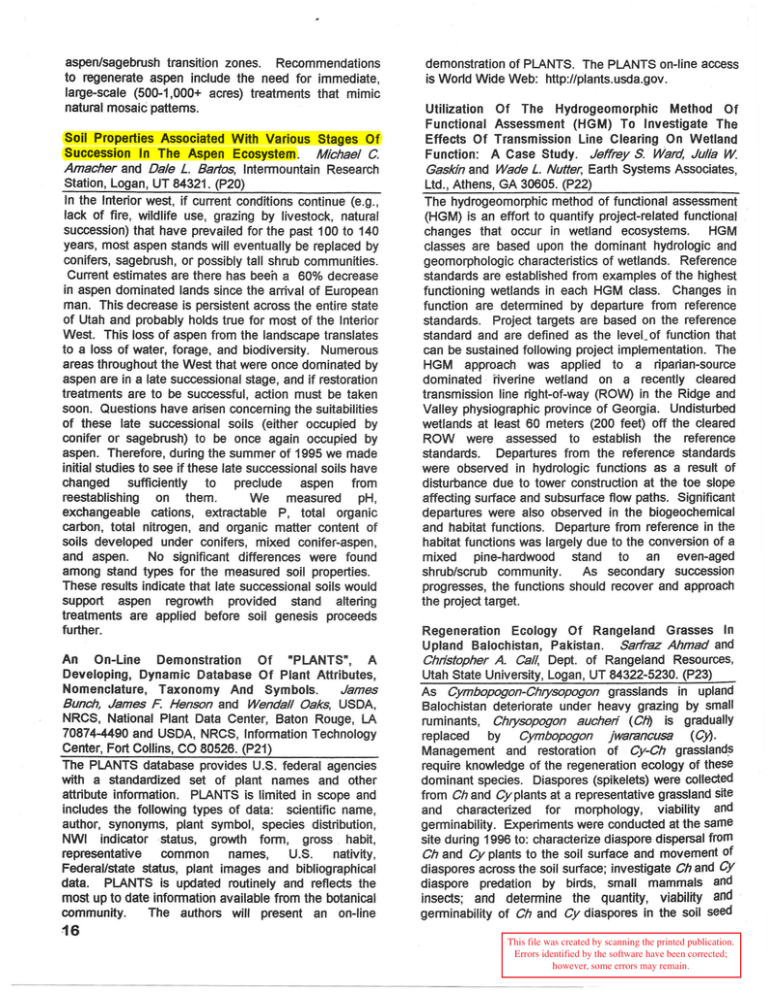aspen/sagebrush transition zones. Recommendations
advertisement

aspen/sagebrush transition zones. Recommendations to regenerate aspen include the need for immediate, large-scale (500-1 ,000+ acres) treatments that mimic natural mosaic patterns. Soil Properties Associated With Various Stages Of Succession In The Aspen Ecosystem. Michael C. Amacher and Dale L. Bartos, Intermountain Research Station, Logan, UT 84321 . (P20) In the Interior west, if current conditions continue (e.g. , lack of fire, wildlife use, grazing by livestock, natural succession) that have prevailed for the past 100 to 140 years, most aspen stands will eventually be replaced by conifers, sagebrush, or possibly tall shrub communities. Current estimates are there has beeh a 60% decrease in aspen dominated lands since the arrival of European man. This decrease is persistent across the entire state of Utah and probably holds true for most of the Interior West. This loss of aspen from the landscape translates to a loss of water, forage, and biodiversity. Numerous areas throughout the West that were once dominated by aspen are in a late successional stage, and if restoration treatments are to be successful, action must be taken soon. Questions have arisen concerning the suitabilities of these late successional soils (either occupied by conifer or sagebrush) to be once again occupied by aspen. Therefore, during the summer of 1995 we made initial studies to see if these late successional soils have changed sufficiently to preclude aspen from reestablishing on them . We measured pH , exchangeable cations, extractable P, total organic carbon, total nitrogen, and organic matter content of soils developed under conifers, mixed conifer-aspen, and aspen. No significant differences were found among stand types for the measured soil properties. These results indicate that late successional soils would support aspen regrowth provided stand altering treatments are applied before soil genesis proceeds further. An On-Line Demonstration Of "PLANTS", A Developing, Dynamic Database Of Plant Attributes, Nomenclature, Taxonomy And Symbols. James Bunch, James F. Henson and Wenda// Oaks, USDA, NRCS, National Plant Data Center, Baton Rouge, LA 70874-4490 and USDA, NRCS, Information Technology Center, Fort Collins, co 80526. (P21) The PLANTS database provides U.S. federal agencies with a standardized set of plant names and other attribute information. PLANTS is limited in scope and includes the following types of data: scientific name, author, synonyms, plant symbol, species distribution, NWI indicator ·status, growth form , gross . habit, U.S. nativity, representative common names, Federal/state status, plant images and bibliographical data. PLANTS is updated routinely and reflects the most up to date information available from the botanical community. The authors will present an on-line 16 demonstration of PLANTS. The PLANTS on-line access is World Wide Web: http://plants.usda.gov. Utilization Of The Hydrogeomorphic Method Of Functional Assessment (HGM) To Investigate The Effects Of Transmission Line Clearing On Wetland Function: A Case Study. JeffreyS. WarO: Julia W Gaskin and Wade L. Nutter, Earth Systems Associates, Ltd., Athens, GA 30605. (P22) The hydrogeomorphic method of functional assessment (HGM) is an effort to quantify project-related functional changes that occur in wetland ecosystems. HGM classes are based upon the dominant hydrologic and geomorphologic characteristics of wetlands. Reference standards are established from examples of the highest functioning wetlands in each HGM class. Changes in function are determined by departure from reference standards. Project targets are based on the reference standard and are defined as the level .. of function that can be sustained following project implementation. The HGM approach was applied to a riparian-source dominated iiverine wetland on a recently cleared transmission line right-of-way (ROW) in the Ridge and Valley physiographic province of Georgia. Undisturbed wetlands at least 60 meters (200 feet) off the cleared ROW were assessed to establish the reference standards. Departures from the reference standards were observed in hydrologic functions as a result of disturbance due to tower construction at the toe slope affecting surface and subsurface flow paths. Significant departures were also observed in the biogeochemical and habitat functions. Departure from reference in the habitat functions was largely due to the conversion of a mixed pine-hardwood stand to an even-aged shrub/scrub community. As secondary succession progresses, the functions should recover and approach the project target. Regeneration Ecology Of Rangeland Grasses In Upland Balochistan, Pakistan. Sarfraz Ahmad and Christopher A. Call, Dept. of Rangeland Resources, Utah State University, Logan, UT 84322-5230. (P23) As Cymbopogon-Chrysopogon grasslands in upland Balochistan deteriorate under heavy grazing by small ruminants, Chrysopogon aucheri ( Cfi) is gradually replaced by Cymbopogon jwarancusa ( CJ1. Management and restoration of Cy-Ch grassland~ require knowledge of the regeneration ecology of these dominant species. Diaspores (spikelets) were collected from Ch and Cy plants at a representative grassland site and characterized for morphology, viability and germinability. Experiments were conducted at the same site during 1996 to: characterize diaspore dispersal from Ch and Cy plants to the soil surface and movement of diaspores across the soil surface; investigate Chand Cy diaspore predation by birds, small mammals and insects; and determine the quantity, viability and germinability of Ch and Cy diaspores in the soil seed This file was created by scanning the printed publication. Errors identified by the software have been corrected; however, some errors may remain.







